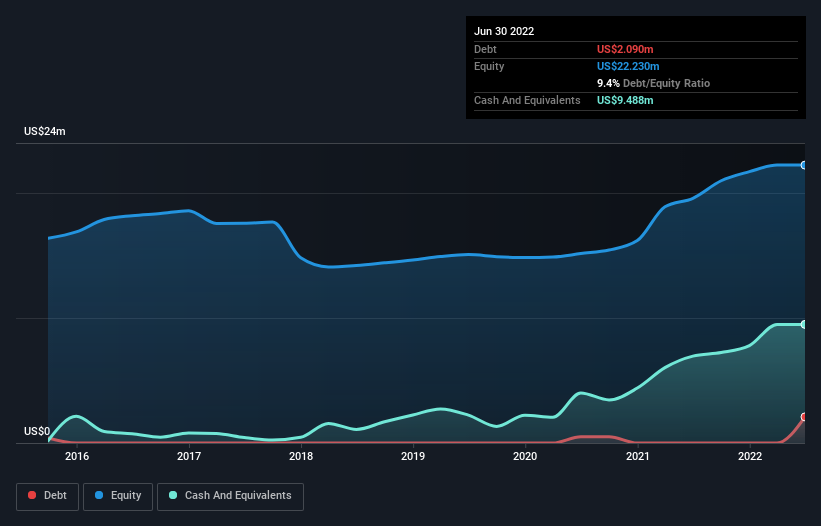These 4 Measures Indicate That Koss (NASDAQ:KOSS) Is Using Debt Reasonably Well
David Iben put it well when he said, 'Volatility is not a risk we care about. What we care about is avoiding the permanent loss of capital.' So it seems the smart money knows that debt - which is usually involved in bankruptcies - is a very important factor, when you assess how risky a company is. Importantly, Koss Corporation (NASDAQ:KOSS) does carry debt. But the more important question is: how much risk is that debt creating?
Why Does Debt Bring Risk?
Debt assists a business until the business has trouble paying it off, either with new capital or with free cash flow. If things get really bad, the lenders can take control of the business. While that is not too common, we often do see indebted companies permanently diluting shareholders because lenders force them to raise capital at a distressed price. Of course, the upside of debt is that it often represents cheap capital, especially when it replaces dilution in a company with the ability to reinvest at high rates of return. The first thing to do when considering how much debt a business uses is to look at its cash and debt together.
See our latest analysis for Koss
What Is Koss's Debt?
The image below, which you can click on for greater detail, shows that at March 2022 Koss had debt of US$2.09m, up from none in one year. But it also has US$9.49m in cash to offset that, meaning it has US$7.40m net cash.
How Healthy Is Koss' Balance Sheet?
We can see from the most recent balance sheet that Koss had liabilities of US$2.48m falling due within a year, and liabilities of US$4.25m due beyond that. Offsetting these obligations, it had cash of US$9.49m as well as receivables valued at US$2.32m due within 12 months. So it can boast US$5.08m more liquid assets than total liabilities.
This short term liquidity is a sign that Koss could probably pay off its debt with ease, as its balance sheet is far from stretched. Succinctly put, Koss boasts net cash, so it's fair to say it does not have a heavy debt load!
Although Koss made a loss at the EBIT level, last year, it was also good to see that it generated US$902k in EBIT over the last twelve months. The balance sheet is clearly the area to focus on when you are analysing debt. But it is Koss's earnings that will influence how the balance sheet holds up in the future. So when considering debt, it's definitely worth looking at the earnings trend. Click here for an interactive snapshot.
But our final consideration is also important, because a company cannot pay debt with paper profits; it needs cold hard cash. While Koss has net cash on its balance sheet, it's still worth taking a look at its ability to convert earnings before interest and tax (EBIT) to free cash flow, to help us understand how quickly it is building (or eroding) that cash balance. Considering the last year, Koss actually recorded a cash outflow, overall. Debt is usually more expensive, and almost always more risky in the hands of a company with negative free cash flow. Shareholders ought to hope for an improvement.
Summing Up
While it is always sensible to investigate a company's debt, in this case Koss has US$7.40m in net cash and a decent-looking balance sheet. So we don't have any problem with Koss's use of debt. When analysing debt levels, the balance sheet is the obvious place to start. However, not all investment risk resides within the balance sheet - far from it. We've identified 3 warning signs with Koss (at least 1 which is a bit unpleasant) , and understanding them should be part of your investment process.
When all is said and done, sometimes its easier to focus on companies that don't even need debt. Readers can access a list of growth stocks with zero net debt 100% free, right now.
Have feedback on this article? Concerned about the content? Get in touch with us directly. Alternatively, email editorial-team (at) simplywallst.com.
This article by Simply Wall St is general in nature. We provide commentary based on historical data and analyst forecasts only using an unbiased methodology and our articles are not intended to be financial advice. It does not constitute a recommendation to buy or sell any stock, and does not take account of your objectives, or your financial situation. We aim to bring you long-term focused analysis driven by fundamental data. Note that our analysis may not factor in the latest price-sensitive company announcements or qualitative material. Simply Wall St has no position in any stocks mentioned.
Join A Paid User Research Session
You’ll receive a US$30 Amazon Gift card for 1 hour of your time while helping us build better investing tools for the individual investors like yourself. Sign up here

 Yahoo Finance
Yahoo Finance 
